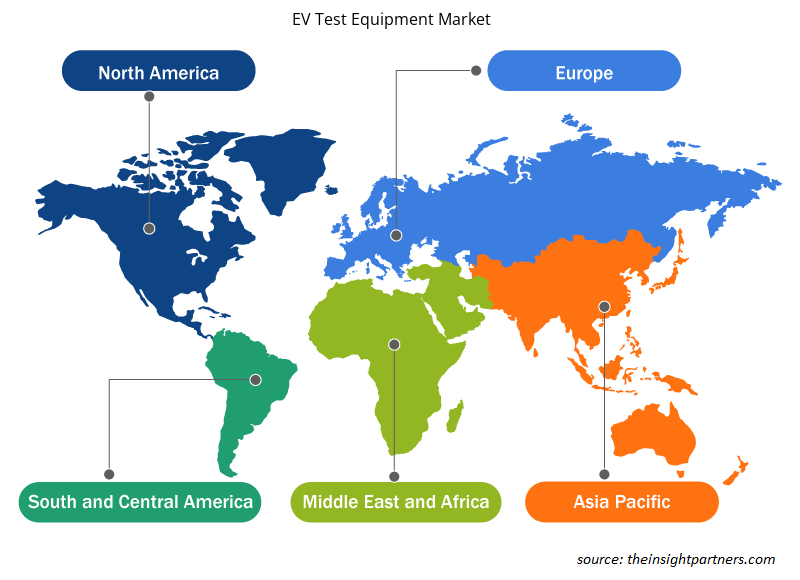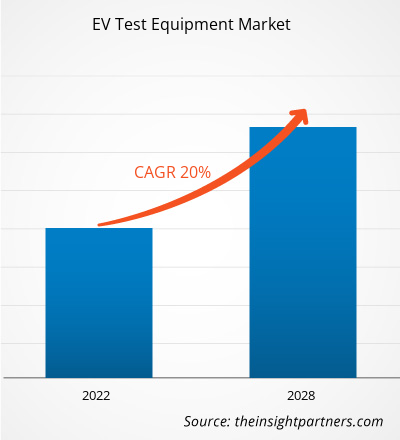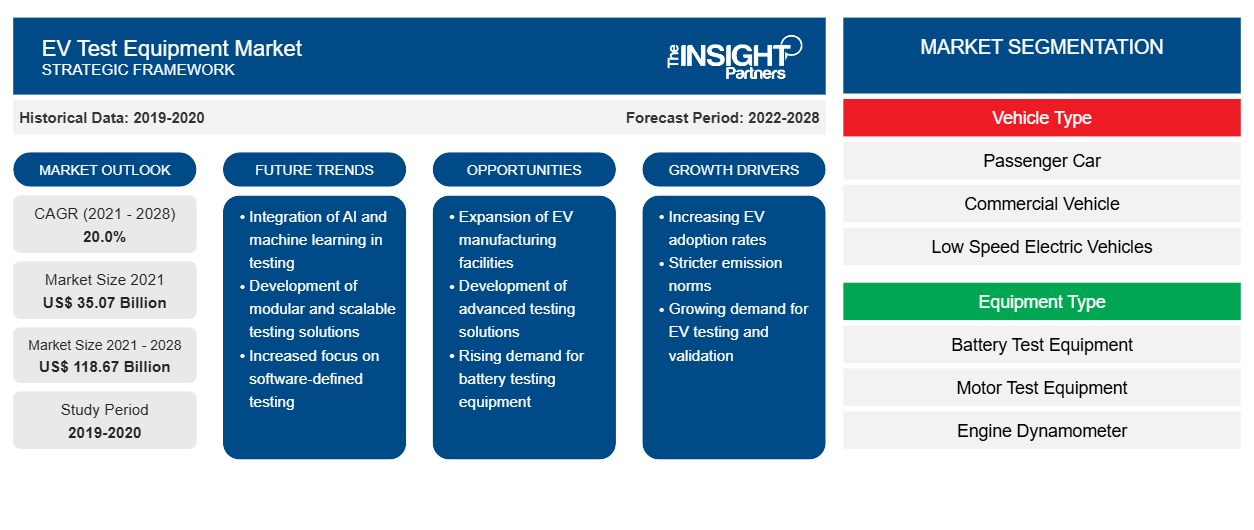Der Markt für Testgeräte für Elektrofahrzeuge soll von 35.072,54 Millionen US-Dollar im Jahr 2021 auf 118.671,47 Millionen US-Dollar im Jahr 2028 wachsen; von 2022 bis 2028 wird mit einer durchschnittlichen jährlichen Wachstumsrate von 20,0 % gerechnet.
Mit EV- Testgeräten werden verschiedene EV- Komponenten wie Batterien, Motoren und andere Komponenten geprüft, um sicherzustellen, dass Autoteile der Konkurrenz voraus sind, eine garantierte Leistung bieten und die Sicherheit und Zufriedenheit der Kunden gewährleisten. Die Testgeräte werden in Elektrofahrzeugen verwendet, um die Gesamtleistung des Fahrzeugs zu bewerten, EV- Batterien und -Ladegeräte zu testen, Leistungselektronik zu testen und Motor und Dynamometer zu testen. Motorprüfgeräte werden verwendet, um das Drehmoment oder elektrische Signal und die hohe Geschwindigkeit eines Elektroautos mithilfe von Sensoren, Spannungssonden und anderer Software zu überprüfen.
Die Verkaufszahlen von Elektroautos sind durch die gestiegene Nachfrage nach Fahrzeugen mit alternativen Kraftstoffen und vernetzter Mobilität gestiegen. Um die Abgase und die Umweltverschmutzung durch Kraftfahrzeuge zu minimieren, haben mehrere Regierungen Vorschriften erlassen, die die Nutzung von Elektrofahrzeugen fördern. Der Markt für Testgeräte für Elektrofahrzeuge wird sich aufgrund der steigenden Nachfrage nach Elektrofahrzeugen voraussichtlich weiterentwickeln . Darüber hinaus ermöglichen höhere Spannungen ein schnelleres Laden, was zur Einführung leistungsstärkerer Batterien, Antriebsstränge und Ladegeräte führt. Infolgedessen wird die Nachfrage nach Testgeräten und Software für Elektrofahrzeuge durch technologische Fortschritte bei neuen Batterietechnologien, die steigende Nachfrage nach elektronischen Funktionen und Merkmalen in einem Fahrzeug sowie strenge Emissionsvorschriften getrieben.
Laut EV-Volumes.com war 2020 ein hervorragendes Jahr für PHEVs, wobei die weltweiten BEV- und PHEV-Verkäufe 3,2 Millionen Einheiten erreichten. In Europa wurden 2020 1,4 Millionen Elektrofahrzeuge zugelassen, 137 % mehr als 2019, selbst nach dem Ausbruch der COVID-19-Pandemie. Dieser Anstieg war bemerkenswert groß für einen Markt, der im Jahresvergleich um 20 % zurückgegangen war. Darüber hinaus übertraf Europa China zum ersten Mal seit 2015 auf dem EV-Markt. Darüber hinaus nehmen viele Unternehmen den öffentlichen Nahverkehr wieder auf, was die Umsetzung zahlreicher Sicherheitsmaßnahmen und -standards erfordert.
Das Aufkommen neuer Softwarelösungen, wie beispielsweise cloudbasierte digitale Lösungen für Echtzeit-Flottenmanagement und Beschleunigung der Elektrifizierung, prägt den globalen Markt für Testgeräte für Elektrofahrzeuge . So ermöglicht die von EVBox angebotene Lademanagementsoftware den Benutzern beispielsweise, ihr Fahrerlebnis mit dem Elektrofahrzeug zu verfolgen, zu verwalten und zu optimieren . Um dies zu überwachen, werden im Prognosezeitraum effiziente, KI-integrierte Testlösungen stark nachgefragt sein.
Passen Sie diesen Bericht Ihren Anforderungen an
Sie erhalten kostenlose Anpassungen an jedem Bericht, einschließlich Teilen dieses Berichts oder einer Analyse auf Länderebene, eines Excel-Datenpakets sowie tolle Angebote und Rabatte für Start-ups und Universitäten.
- Holen Sie sich die wichtigsten Markttrends aus diesem Bericht.Dieses KOSTENLOSE Beispiel umfasst eine Datenanalyse von Markttrends bis hin zu Schätzungen und Prognosen.
Auswirkungen der COVID-19-Pandemie auf den europäischen Markt für Testgeräte für Elektrofahrzeuge
Der Ausbruch von COVID-19 und der Weg zur Erholung hatten verschiedene Auswirkungen auf das Straßennetz. 2020 gab es in ganz Europa einen Anstieg der Käufe von Testgeräten für Elektrofahrzeuge. So verzeichneten Deutschland, Frankreich und Italien im ersten Halbjahr 2020 55 % mehr Elektroautos in Europa als 2019. Das Wachstum des Marktes für Testgeräte für Elektrofahrzeuge in Europa ist auf die steigende Notwendigkeit der Hersteller zurückzuführen, ab Januar 2020 die strengeren CO2-Standards der Europäischen Union für neue Personenkraftwagen und Lieferwagen einzuhalten. Das in Deutschland ansässige VDE-Institut ist auf Wissenschaft, Standardisierung, Produktprüfung, Zertifizierung und Anwendungsberatung spezialisiert. 2019 wurde das VDE-Institut vom Kraftfahrt-Bundesamt zum technischen Dienst der Kategorien A, B und D ernannt, was es ihm ermöglicht, Tests an Elektrofahrzeugen auf Grundlage der Straßenverkehrsordnung, des Fahrzeugteilegesetzes und der Vorschriften gemäß dem Übereinkommen der Wirtschaftskommission für die Vereinten Nationen für Europa (ECE-Vorschriften) durchzuführen. Die vom VDE-Institut durchgeführten Prüfungen und Zertifizierungen gewährleisten eine reibungslose Mobilität und Datensicherheit im Gesamtsystem, das Ladeinfrastruktur, Ladestationen und Wallboxen umfasst, während der frühen Entwicklungsphase eines Produkts bis hin zu den abschließenden Zulassungsprüfungen (Validierungsprüfungen). Das Vorhandensein eines großen EV-Marktes, Institutionen mit jahrzehntelanger Erfahrung in der Prüfung der elektrischen Sicherheit und die wachsenden Anforderungen an die Prüfung der im Fahrzeug integrierten elektronischen Komponenten treiben das Wachstum des Marktes für EV-Testgeräte in Europa voran.EV test equipment across Europe in 2020. For instance, Germany, France, and Italy registered 55% higher electric car sales in Europe during the first half of 2020 than in 2019. The growth of the EV test equipment market in Europe is due to the rising need for manufacturers to comply with stricter European Union CO2 standards for new VDE Institute specializes in science, standardization, product testing, certification, and application consulting. In 2019, The VDE Institute was appointed as a category A, B, and D technical service by the Federal Motor Vehicle Transport Authority, which enables it to perform tests on electric vehicles based on the Highway Traffic Act, the Vehicle Parts Act, and regulations according to the Agreement of the Economic Commission for a United Nations of Europe (ECE regulations). Testing and certification carried out by the VDE Institute ensure trouble-free mobility and data security in the overall system, which includes the charging infrastructure, charging stations, and wall boxes during a product’s early development phase for final approval (validation) tests. The presence of a large EV market, institutions with decades of experience in testing electrical safety, and growing requirements to test the electronic components integrated into the vehicle is propelling the growth of the EV test equipment market in Europe.
Einblicke in den Markt für Testgeräte für Elektrofahrzeuge
Innovative Ladestationstechnologien wie Turboaufladung, Terra HP-Aufladung, intelligente Ladesysteme, drahtlose Stromübertragung und bidirektionale Ladegeräte werden von Herstellern von Ladestationen für Elektrofahrzeuge entwickelt . Solche Fortschritte bei Ladesystemen für Elektrofahrzeuge erfordern verbesserte Testverfahren. Testsysteme für Ladestationen für Elektrofahrzeuge sind von Unternehmen wie ROLEC , DEKRA und TÜV Rheinland erhältlich . Intelligentes Laden ist eines der fortschrittlichsten Ladesysteme. Intelligentes Laden ermöglicht Lastausgleich und proportionale Verteilung der verfügbaren Stromkapazität auf alle aktiven Ladestationen. Es erleichtert auch die Erfassung wichtiger Ladedaten von verschiedenen Stationen über eine einzige Cloud-basierte Verwaltungsplattform.
Fahrzeugtypbasierte Markteinblicke
Basierend auf dem Fahrzeugtyp ist der Markt für EV- Testgeräte in Pkw, Nutzfahrzeuge und langsame Elektrofahrzeuge unterteilt . Im Jahr 2021 hatte das Pkw-Segment den größten Marktanteil an EV -Testgeräten.
Markteinblicke basierend auf Gerätetypen
Basierend auf dem Gerätetyp ist der Markt für EV- Testgeräte in Batterietestgeräte, Motortestgeräte, Motorprüfstände, Fahrgestellprüfstände, Getriebeprüfstände, Einspritzpumpentester, Wechselrichtertester, EV-Antriebsstrangtester, Bordladegeräte und AC/DC EVSE unterteilt . Im Jahr 2021 hatte das Segment Batterietestgeräte den größten Marktanteil an EV- Testgeräten.
Anwendungsbasierte Markteinblicke
Basierend auf der Anwendung ist der Markt für EV-Testgeräte in EV-Komponenten- und Antriebssysteme, EV-Laden und Antriebsstrang segmentiert. Im Jahr 2021 hatte das Segment Antriebsstrang den größten Marktanteil bei EV-Testgeräten.
Endbenutzerbasierte Markteinblicke
Basierend auf den Endnutzern ist der Markt für EV-Testgeräte in OEMs, Tier-1-Zulieferer, Forschung und Lehre sowie Sonstige unterteilt. Im Jahr 2021 hatte das Segment der Tier-1-Zulieferer den größten Marktanteil an EV-Testgeräten.
Marktteilnehmer verfolgen Strategien wie Fusionen, Übernahmen und Marktinitiativen, um ihre Positionen in der Marktprognose für EV-Testgeräte zu behaupten. Nachfolgend sind einige Entwicklungen der wichtigsten Akteure im Marktbericht für EV-Testgeräte aufgeführt:
- Die Eröffnung des Engineering Innovation Centre (EIC) von NI in Bangalore wurde im März 2022 angekündigt. Die technische Einrichtung wird Kunden, Partnern und Start-up-Unternehmen von NI helfen, die den lokalen Luft- und Raumfahrt- und Militärsektor bedienen. Das EIC wird auch genutzt, um der nächsten Generation von Ingenieuren in der Luft- und Raumfahrt- und Militärindustrie Systemverständnis beizubringen.
- Im Jahr 2021 haben sich Keysight Technologies, Inc. und Proventia Oy zusammengetan, um Batterietestlösungen für Elektrofahrzeuge (EVs) zu entwickeln. Durch die Partnerschaft zwischen Keysight und Proventia entsteht eine ortsunabhängige, sichere Testeinrichtung, die schnell umgesetzt werden kann.
Regionale Einblicke in den Markt für Testgeräte für Elektrofahrzeuge
Die regionalen Trends und Faktoren, die den Markt für Testgeräte für Elektrofahrzeuge im Prognosezeitraum beeinflussen, wurden von den Analysten von Insight Partners ausführlich erläutert. In diesem Abschnitt werden auch die Marktsegmente und die Geografie von Testgeräten für Elektrofahrzeuge in Nordamerika, Europa, im asiatisch-pazifischen Raum, im Nahen Osten und Afrika sowie in Süd- und Mittelamerika erörtert.

- Erhalten Sie regionale Daten zum Markt für Testgeräte für Elektrofahrzeuge
Umfang des Marktberichts zu Testgeräten für Elektrofahrzeuge
| Berichtsattribut | Details |
|---|---|
| Marktgröße im Jahr 2021 | 35,07 Milliarden US-Dollar |
| Marktgröße bis 2028 | 118,67 Milliarden US-Dollar |
| Globale CAGR (2021 - 2028) | 20,0 % |
| Historische Daten | 2019-2020 |
| Prognosezeitraum | 2022–2028 |
| Abgedeckte Segmente | Nach Fahrzeugtyp
|
| Abgedeckte Regionen und Länder | Nordamerika
|
| Marktführer und wichtige Unternehmensprofile |
|
Dichte der Marktteilnehmer für Testgeräte für Elektrofahrzeuge: Auswirkungen auf die Geschäftsdynamik verstehen
Der Markt für Testgeräte für Elektrofahrzeuge wächst rasant. Dies wird durch die steigende Nachfrage der Endnutzer aufgrund von Faktoren wie sich entwickelnden Verbraucherpräferenzen, technologischen Fortschritten und einem größeren Bewusstsein für die Vorteile des Produkts vorangetrieben. Mit steigender Nachfrage erweitern Unternehmen ihr Angebot, entwickeln Innovationen, um die Bedürfnisse der Verbraucher zu erfüllen, und nutzen neue Trends, was das Marktwachstum weiter ankurbelt.
Die Marktteilnehmerdichte bezieht sich auf die Verteilung der Firmen oder Unternehmen, die in einem bestimmten Markt oder einer bestimmten Branche tätig sind. Sie gibt an, wie viele Wettbewerber (Marktteilnehmer) in einem bestimmten Marktraum im Verhältnis zu seiner Größe oder seinem gesamten Marktwert präsent sind.
Die wichtigsten auf dem Markt für Testgeräte für Elektrofahrzeuge tätigen Unternehmen sind:
- National Instruments Corporation
- Horiba Ltd.
- Arbin-Instrumente
- Maccor Inc.
- KEYSIGHT TECHNOLOGIES, INC.
Haftungsausschluss : Die oben aufgeführten Unternehmen sind nicht in einer bestimmten Reihenfolge aufgeführt.

- Überblick über die wichtigsten Akteure auf dem Markt für Testgeräte für Elektrofahrzeuge
Firmenprofile
- National Instruments Corporation
- Horiba GmbH
- Arbin-Instrumente
- Maccor Inc
- KEYSIGHT TECHNOLOGIES, INC
- Froude, Inc
- Dynomerk-Steuerungen
- Comemso electronics GmbH
- Dürr Group
- TÜV RHEINLAND
- INTERTEK GROUP PLC
- TOYO SYSTEM CO., LTD
- WONIK PNE CO., LTD
- Historische Analyse (2 Jahre), Basisjahr, Prognose (7 Jahre) mit CAGR
- PEST- und SWOT-Analyse
- Marktgröße Wert/Volumen – Global, Regional, Land
- Branchen- und Wettbewerbslandschaft
- Excel-Datensatz
Aktuelle Berichte
Erfahrungsberichte
Grund zum Kauf
- Fundierte Entscheidungsfindung
- Marktdynamik verstehen
- Wettbewerbsanalyse
- Kundeneinblicke
- Marktprognosen
- Risikominimierung
- Strategische Planung
- Investitionsbegründung
- Identifizierung neuer Märkte
- Verbesserung von Marketingstrategien
- Steigerung der Betriebseffizienz
- Anpassung an regulatorische Trends





















 Kostenlose Probe anfordern für - Markt für EV-Testgeräte
Kostenlose Probe anfordern für - Markt für EV-Testgeräte